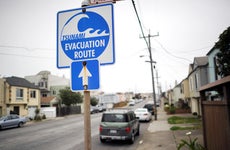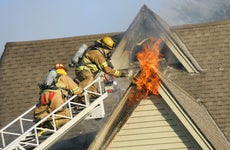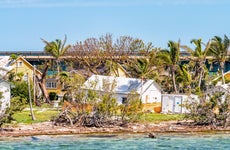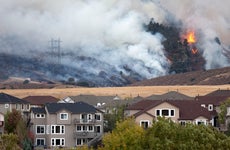Does homeowners insurance cover volcanic eruptions?
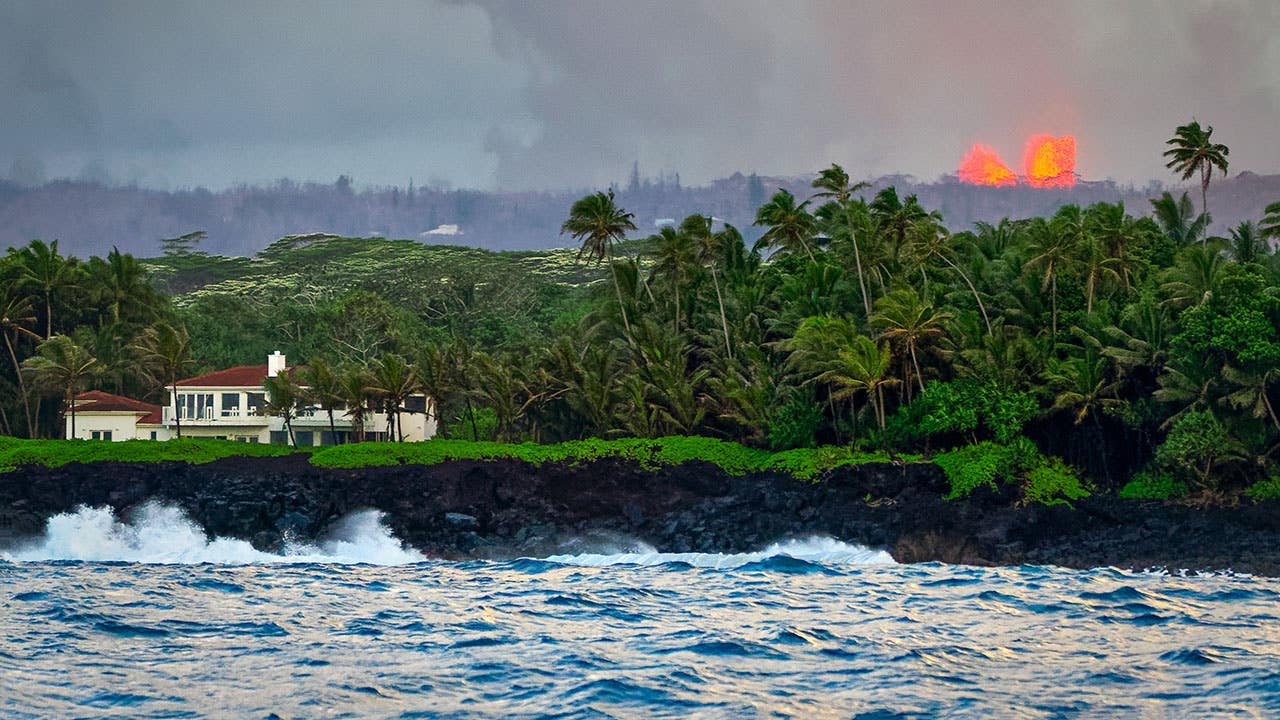
The Bankrate promise
At Bankrate, we strive to help you make smarter financial decisions. To help readers understand how insurance affects their finances, we have licensed insurance professionals on staff who have spent a combined 47 years in the auto, home and life insurance industries. While we adhere to strict , this post may contain references to products from our partners. Here's an explanation of . Our content is backed by Coverage.com, LLC, a licensed entity (NPN: 19966249). For more information, please see our .
Damage from a volcanic eruption is usually not a top concern for most homeowners compared to losses from fire and wind — however, for some owners, it should be. According to the American Geosciences Institute (AGI), about 169 active volcanoes exist in the U.S., with Alaska being home to most of them. While volcano damage is a covered peril on most homeowners insurance policies, it does not supersede excluded damages. Along with volcanic eruptions may come floods, mudslides, tsunamis, power outages and earthquakes, which typically require additional endorsements or policies for coverage. Bankrate’s insurance editorial team, including licensed insurance agents and editors with combined decades of experience, has gathered information about volcanic eruption loss and supplemental coverage types to help you make informed decisions about your homeowners insurance coverage.
What damage can a volcanic eruption cause to my home?
Of the 169 active volcanoes in the U.S., the U.S. Geological Survey (USGS) categorizes 54 volcanos as a high or very high threat to public safety. Alaska has 141 active volcanoes and averages an eruption around once per year. The USGA monitors all active volcanoes with special attention to ones in Alaska, California, Hawaii, Oregon and Washington (Yellowstone).
If a volcanic eruption were to happen, your home may be damaged by one of the following volcanic hazards:
- Pyroclastic density current: Fast-moving and dense mixture of hot gasses, ash and volcanic fragments that flows down the volcano and across the ground
- Pyroclastic fall/Tephra fall: Volcanic material returning to the ground after a volcanic eruption
- Volcanic effusion: Volcanic water and mud flow
- Lava flow: Streams of molten rock
- Sector collapse: Structural failure of a volcano
- Volcanic ash/Ash fall: Small mixture of glass, minerals and rock released into the air after a volcanic blast
The area at highest risk is within 20 miles of a volcano. Pyroclastic density currents (PDC) can project gas and volcanic material up to the size of boulders greater than 50 mph and temperatures between 390 and 1300 degrees Fahrenheit. Structures that experience PDC are usually destroyed. Falling volcanic ash can damage homes hundreds of miles away by causing fires or collapse due to the weight of ash accumulation on roofs and gutters. Ash can also destroy the systems inside HVAC units and home generators. Depending on the location, your home may experience minor cosmetic damage or severe structural damage.
Does a homeowners insurance policy cover volcanic eruptions?
Yes, damage from volcanic eruption is a commonly covered peril under most homeowners insurance policies. According to the Insurance Information Institute (Triple-I), damage from airborne shockwaves, ash, dust, explosion, fire, lava flow and volcanic blast are typically covered by homeowners insurance. Coverage includes payment up to your policy’s limit to repair damage to your dwelling, other structures and personal property. However, there are limitations every homeowner should know about.
What volcanic eruption damage is not covered by a homeowner policy?
Homeowners insurance usually covers damage from ash, but may not cover general ash removal from the dwelling if there is no other damage. Ash removal from the surrounding property is usually not covered. Typically, it will state in your policy documents that volcanic eruption coverage excludes loss from earthquake, landshock waves and tremors. Once a volcano erupts, it can trigger several natural events that are listed under the homeowners insurance exclusions portion of your policy. Some of the volcanic hazards generally not covered by insurance are:
- Earthquakes
- Tsunamis
- Lahars (mudflow)
- Flash floods
- Jökulhlaups (glacial outburst floods)
- Landslides
- Damage that happens to your property that was triggered by a volcano eruption, such as erosion on a metal roof
However, homeowners with separate earthquake insurance or flood insurance policies most likely have coverage for many of the secondary hazards caused by volcanoes. Triple-I states that mudflows and flooding usually have coverage from flood policies purchased through FEMA’s National Flood Insurance Program (NFIP) or private insurers. Tsunami damage may be covered by payouts from a flood policy for water damage and payouts from an earthquake policy for structural damage. Earthquakes caused by volcanoes are typically covered by earthquake insurance, but landslides not caused by seismic activity are not.
What other natural disasters are covered under homeowners insurance?
Volcanic eruptions are not the only natural disasters covered by homeowners insurance policies. Aside from volcanic eruptions, some of the natural disasters that are likely covered under your homeowners insurance include tornadoes, hurricanes, lightning, explosions, extreme cold and fire.
Homeowners living in areas prone to wildfires, like California, may have wildfire damage excluded from their policies. If you are in this situation, speak with your agent to determine if your stand-alone wildfire insurance policy covers fires started by volcanoes. Many homeowners in states like Florida and Louisiana have the option for separate windstorm insurance when their home insurance policies have wind damage exclusions.
What should you do if your home is damaged by a volcanic eruption or another natural disaster?
If your home is damaged by a natural disaster, like a volcanic eruption, you should first contact your insurer to file a home insurance claim. Since you likely won’t have access to your physical insurance policy at the time, try to access your policy documents online or through your insurer’s mobile app to verify that you have volcanic eruption coverage. A claims agent can also usually advise whether you have coverage for this type of loss over the phone. Once the claim is set up, an adjuster will schedule a time to survey your property for damage.
In the meantime, you will want to secure your property to prevent further damage and document the site. Take as many pictures as you can. Many providers allow policyholders to submit claim pictures via its app, making your claims process much quicker. If you can not enter your home, make an itemized list of what was in each room to help the adjuster with the personal property portion of the claim. You may want to check online bank records for any recent purchases of note, such as new furniture or big ticket electronics or appliances.
The weight of ash can collapse dwellings and other structures and cause water to back up onto the property and into the home. When it is safe to do so, remove ash from rooftops, gutters and HVAC systems. When cleaning up after a volcanic eruption, the U.S. Department of the Interior recommends wearing thick gloves, a face mask, working when other safety crews are present and maintaining proper ventilation.
Frequently asked questions
-
-
Home insurance doesn’t have a separate volcano insurance policy, but damage from volcanic eruptions is covered under most home insurance policies. However, a volcanic eruption can initiate other types of natural disasters not covered by most home insurance, such as flooding, earthquakes, mud and landslides. If you live in Alaska, California, Hawaii, Oregon and Washington, locations in the U.S. with the highest number of active volcanoes, you may want to speak to your insurance agent about additional endorsements or policies for more comprehensive coverage.
-
Yes, if you have comprehensive coverage on your car insurance policy, you are likely covered for damage to your vehicle from a volcanic eruption. Comprehensive insurance covers damage to your car up to its actual cash value (ACV) for losses from fire, theft, falling objects and more. Vehicles with liability-only insurance are not covered to have physical damage repaired in this situation.
-
While there is no such thing as lava insurance, most home insurance policies cover damage from lava flow. Volcanic eruption coverage is a standard peril that does not have an individual premium associated with it.
-
Unless you can build your home from the ground up using titanium or tungsten stilts, concrete walls and triple-reinforced roofs, properly maintaining your home is the best course of action against preventable damage. Ash weighs twice as much as snow, so try to keep your roof in excellent condition at all times. Installing hurricane shutters can also help keep debris out of your home. Along with following the Centers for Disease Control (CDC) safety guide, additional measures to protect your property include storing vehicles inside garages and safely cleaning debris once the event has passed.
-
Related Articles
